ECU CHEVROLET TRACKER 1998 1.G Owners Manual
[x] Cancel search | Manufacturer: CHEVROLET, Model Year: 1998, Model line: TRACKER, Model: CHEVROLET TRACKER 1998 1.GPages: 386, PDF Size: 21.17 MB
Page 16 of 386
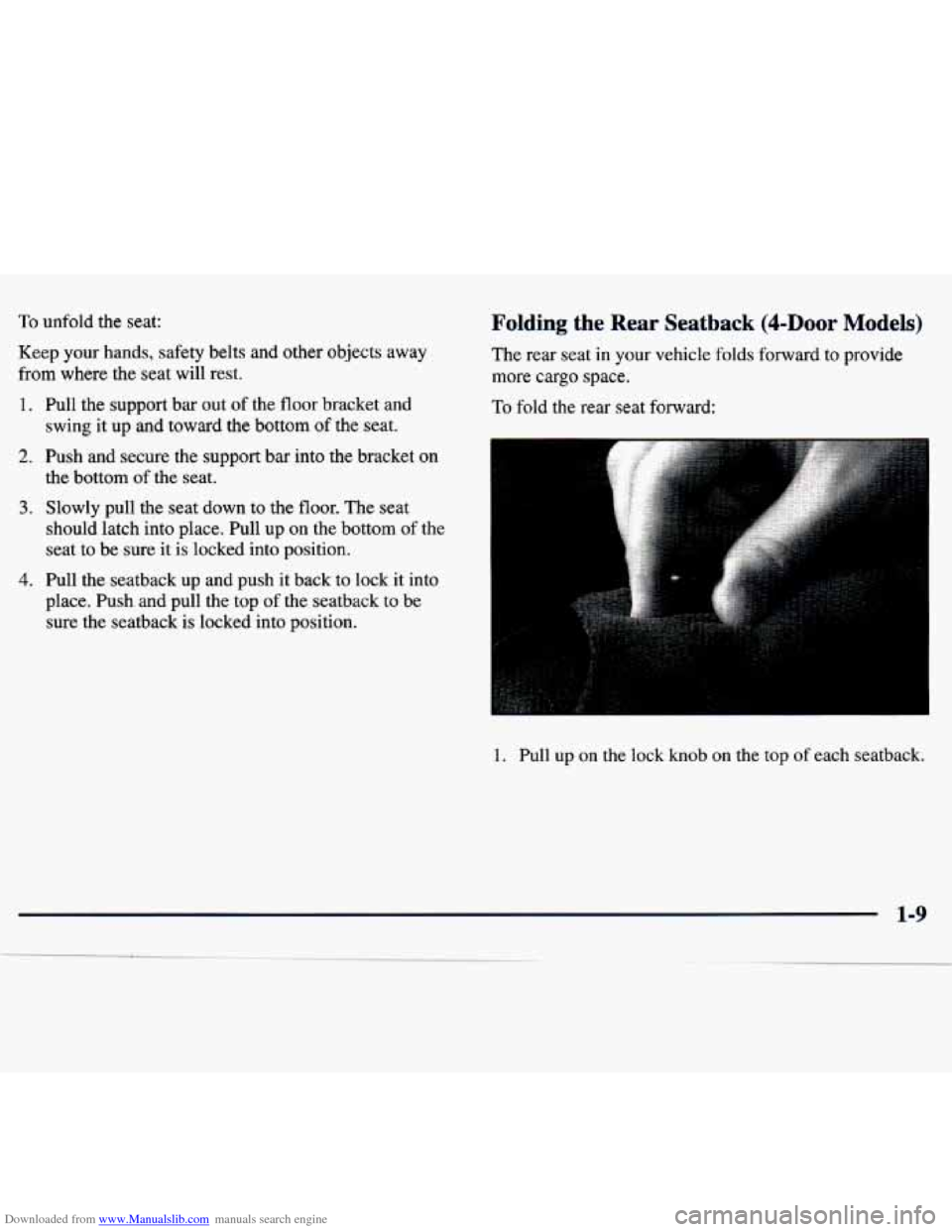
Downloaded from www.Manualslib.com manuals search engine To unfold the seat:
Keep your hands, safety belts and other objects away
from where the seat will rest.
1. Pull the support bar out of the floor bracket and
swing it up and toward the bottom
of the seat.
2. Push and secure the support bar into the bracket on
the bottom
of the seat.
Folding the Rear Seatback (4-h~ Models)
The rear seat in your vehicle folds forward to provide
more
cargo space.
To fold the rear seat forward:
3. Slowly pull the seat down to the floor; The seat
should latch into place. Pull up on the bottom
of the
seat to be sure it is locked into position.
4. Pull the seatback up and push it back to lock it into
place. Push and pull the top
of the seatback to be
sure the seatback is locked into position.
1. Pull up on the lock knob on the top of each seatback.
1-9
Page 19 of 386
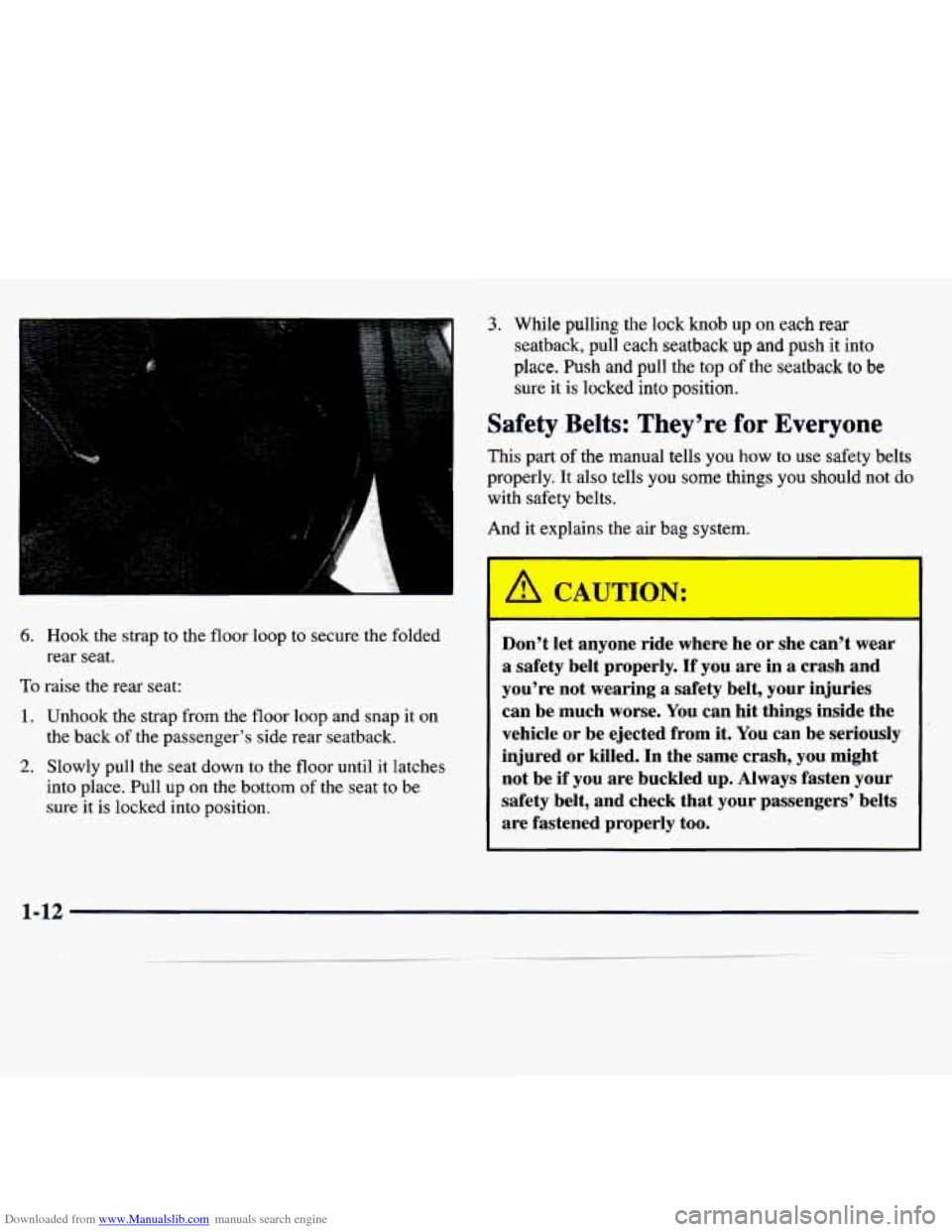
Downloaded from www.Manualslib.com manuals search engine 3. While pulling the lock knob up on each rear
seatback, pull each seatback up and push it into
place.
Push and pull the top of the seatback to be
sure it is locked into position.
1 Safety Belts: They’re for Everyone
This part of the manual tells you how to use safety belts
properly. It also tells
you some things you should not do
with safetv belts.
I
I
And it explains the air bag system.
6. Hook the strap to the floor loop to secure the folded
rear seat.
To raise the rear seat:
1. Unhook the strap from the floor loop and snap it on
the back
of the passenger’s side rear seatback.
2. Slowly pull the seat down to the floor until it latches
into place. Pull up on the bottom
of the seat to be
sure it is locked into position. Don’t
let anyone ride where he
or she can’t wear
a safety belt properly. If you are in a crash and
you’re not wearing
a safety belt, your injuries
can be much worse. You can hit things inside the
vehicle or be ejected from it. You can be seriously
injured or killed. In the same crash, you might
not be if you are buckled up. Always fasten your
safety belt, and check that your passengers’ belts
are fastened properly too.
1-12
Page 25 of 386
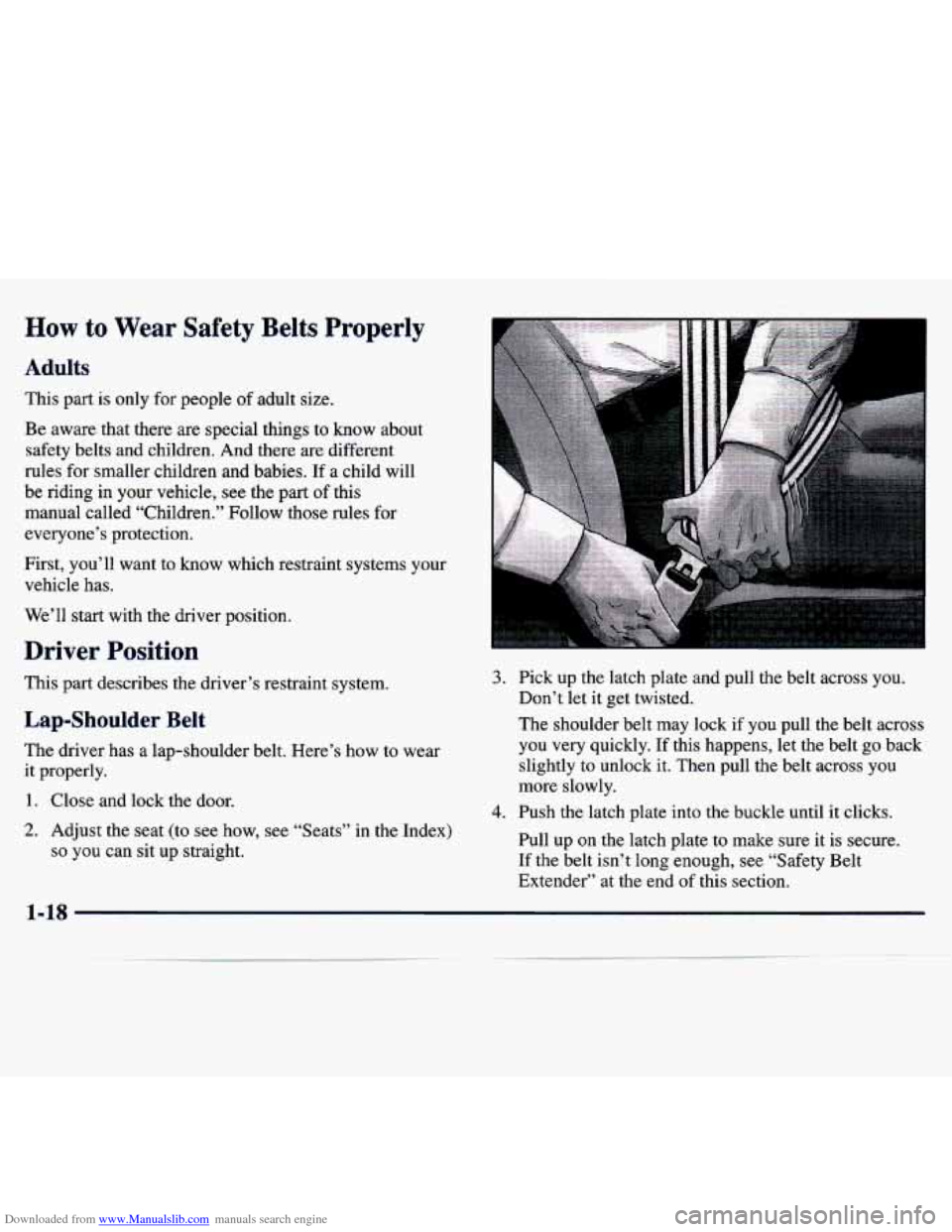
Downloaded from www.Manualslib.com manuals search engine How to Wear Safety Belts Properly
Adults
This part is only for people of adult size.
Be aware that there are special things to know about
safety belts and children. And there are different
rules for smaller children and babies. If
a child will
be riding in your vehicle, see the part of this
manual called “Children.” Follow those rules for
everyone’s protection.
First, you’ll want to know which restraint systems your
vehicle has.
We’ll start
with the driver position.
Driver Position
This part describes the driver’s restraint system.
Lap-Shoulder Belt
The driver has a lap-shoulder belt. Here’s how to wear
it properly.
1. Close and lock the door.
2. Adjust the seat (to see how, see “Seats” in the Index)
so you can sit up straight.
3. Pick up the latch plate and pull the belt across you.
Don’t let it get twisted.
The shoulder belt may lock
if you pull the belt across
you very quickly. If this happens, let the belt
go back
slightly to unlock it. Then pull the belt across you
more slowly.
4. Push the latch plate into the buckle until it clicks.
Pull up on the latch plate to make sure it is secure.
If the belt isn’t long enough, see “Safety Belt
Extender” at the end of this section.
Page 33 of 386
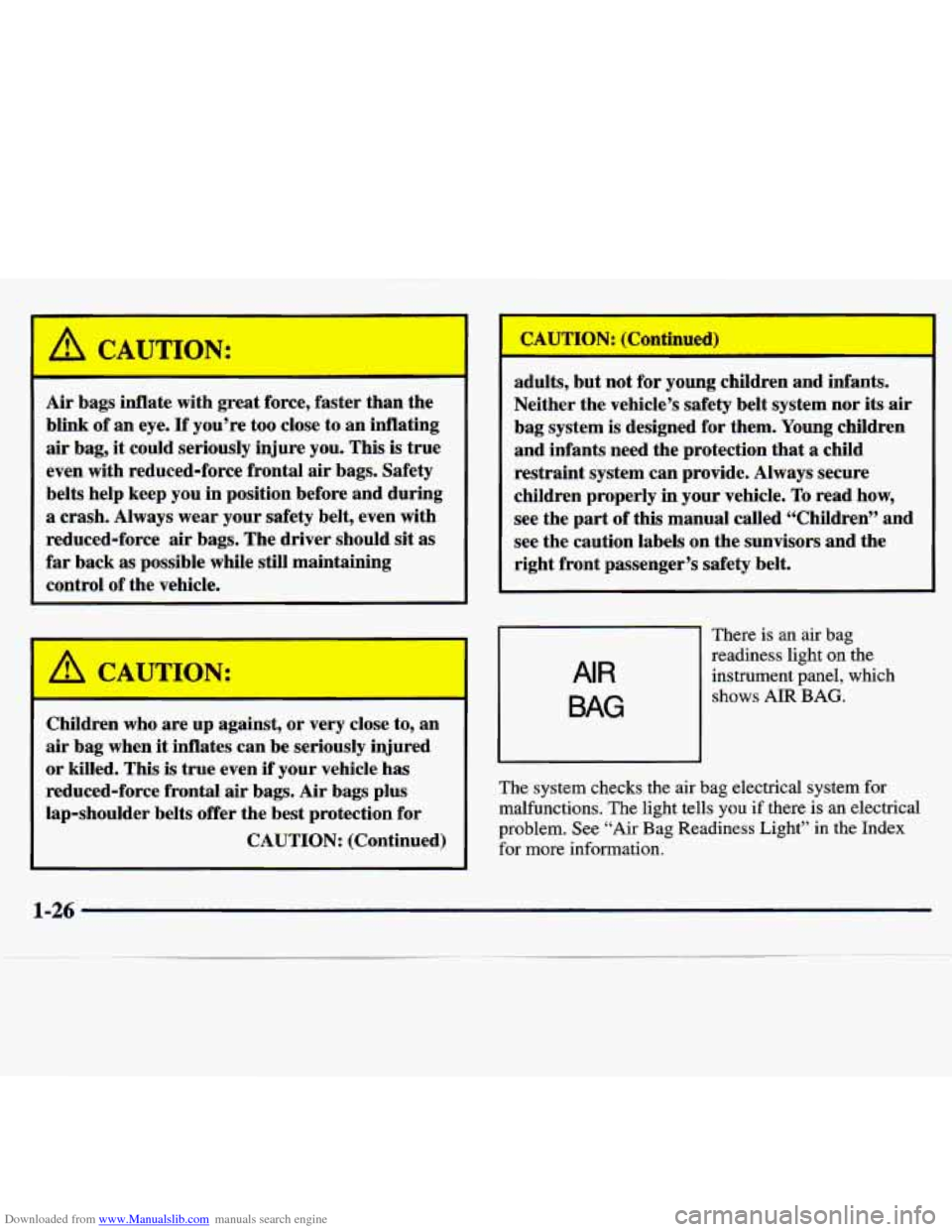
Downloaded from www.Manualslib.com manuals search engine Air bags inflate with great force, faster than the
blink of an eye.
If you’re too close to an inflating
air bag, it could seriously injure you. This is true
even
with reduced-force frontal air bags. Safety
belts help keep you in position before and during
a crash. Always wear your safety belt, even with
reduced-force air bags. The driver should sit as
far back as possible while still maintaining
control of the vehicle.
6& CAWTION:
Children who are up against, or very close to, an
air bag when it inflates can be seriously injured
or killed. This is true even
if your vehicle has
reduced-force frontal air bags. Air bags plus
lap-shoulder belts offer the best protection for
CAUTION: (Continued) adults, but not
for young children
and infants.
Neither the vehicle’s safety belt system nor its air
bag system is designed for them. Young children
and infants need the protection that a child
restraint system can provide. Always secure
children properly in your vehicle.
To read how,
see the part of this manual called (‘Children” and
see the caution labels on the sunvisors and the
right front passenger’s safety belt.
AIR
BAG
There is an air bag
readiness light on the
instrument panel, which
shows AIR BAG.
The system checks the air
bag electrical system for
malfunctions. The light tells you if
there is an electrical
problem. See “Air Bag Readiness Light” in the
Index
for more information.
Page 39 of 386
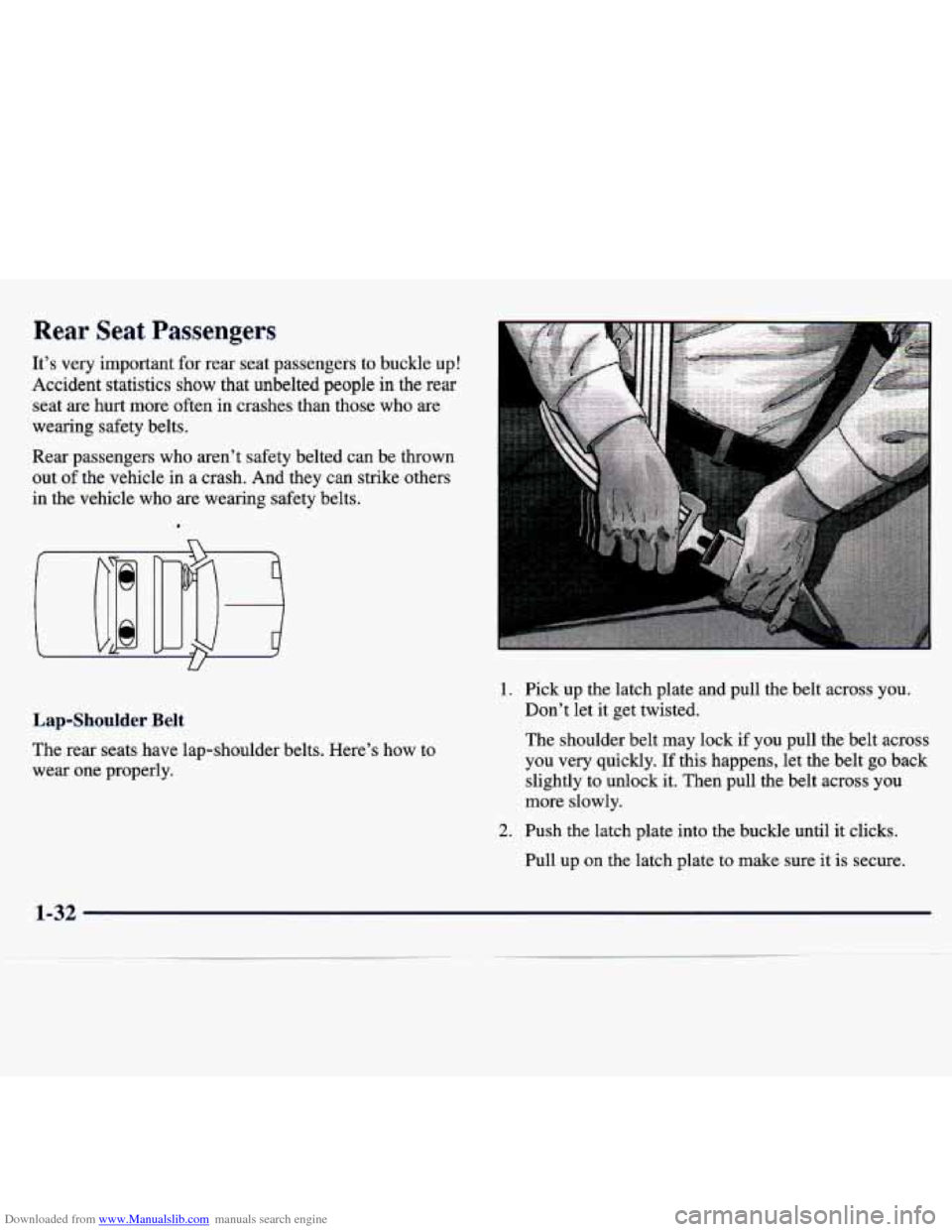
Downloaded from www.Manualslib.com manuals search engine Rear Seat Passengers
It’s very important for rear seat passengers to buckle up!
Accident statistics show that unbelted people in the rear
seat are hurt more often in crashes than those who are
wearing safety belts.
Rear passengers who aren’t safety belted can be thrown out of the vehicle in a crash. And they can strike others
in the vehicle who
are wearing safety belts.
Lap-Shoulder Belt
The rear seats have lap-shoulder belts. Here’s how to
wear one properly.
1. Pick up the latch plate and pull the belt across you.
Don’t let it get twisted.
The shoulder belt may lock if you pull the belt across
you very quickly. If this happens, let the belt
go back
slightly to unlock it. Then pull the belt across you
more slowly.
2. Push the latch plate into the buckle until it clicks.
Pull
up on the latch plate to make sure it is secure.
1-32
Page 42 of 386
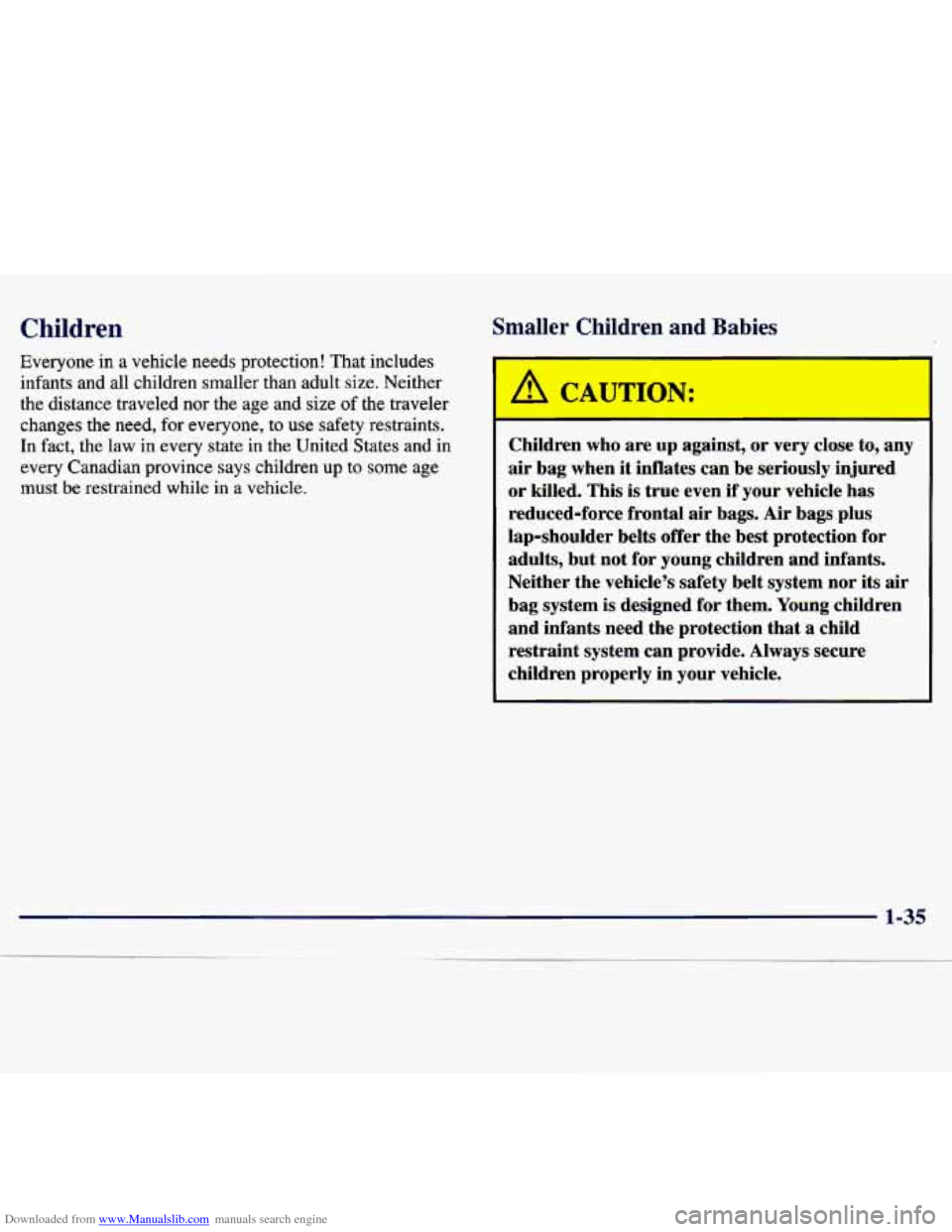
Downloaded from www.Manualslib.com manuals search engine Children
Everyone in a vehicle needs protection! That includes
infants and all children smaller than adult size. Neither
the distance traveled nor the age and size
of the traveler
changes the need, for everyone, to
use safety restraints.
In fact, the law in every
state in the United States and in
every Canadian province says children
up to some age
must
be restrained while in a vehicle.
Smaller Children and Babies
A CAUTION:
Children who are up against, or very close to, any
air bag when it inflates can be seriously injured
or killed. This is true even if your vehicle has
reduced-force frontal air bags. Air bags plus
lap-shoulder belts offer the best protection for
adults, but not for young children and infants.
Neither the vehicle’s safety belt system nor its air
bag system is designed for them. Young children
and infants need the protection that a child
restraint system can provide. Always secure
children properly in your vehicle.
1-35
.- -
Page 43 of 386
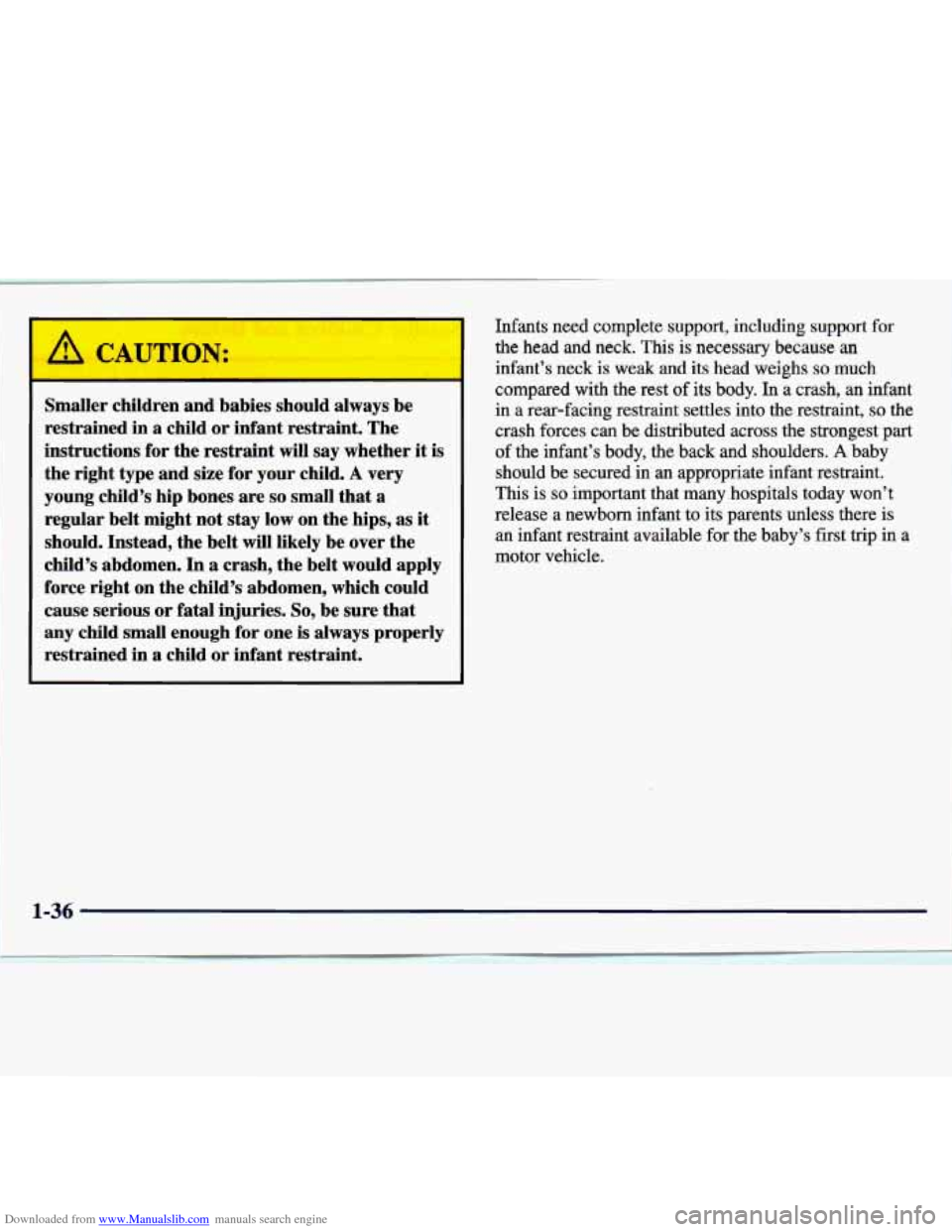
Downloaded from www.Manualslib.com manuals search engine I
SwaIler children and babies should always be
restrained
in a child or infant restraint. The
instructions for the restraint
will say whether it is
the right type and size for your child. A very
young child’s hip bones are so small that a
regular belt might not stay low on the hips, as it
should. Instead, the belt will likely be over the
child’s abdomen.
In a crash, the belt would apply
force right on the child’s abdomen, which could
cause serious or fatal injuries.
So, be sure that
any child
mall enough for one is always properly
restrained
in a child or infant restraint.
Infants need complete support, including support for
the head and neck. This is necessary because an
infant’s neck is weak and its fiead weighs so much
compared with the rest of its body. In a crash, an infant
in a rear-facing restraint settles into the restraint,
so the
crash forces can be distributed across
the strongest part
of the infant’s body,
the back and shoulders. A baby
should be secured
in an appropriate infant restraint.
This is
so important that many hospitals today won’t
release a newborn
infant to its parents unless there is
an infant restraint available
for the baby’s first trip in a
motor vehicle.
1-36
Page 44 of 386
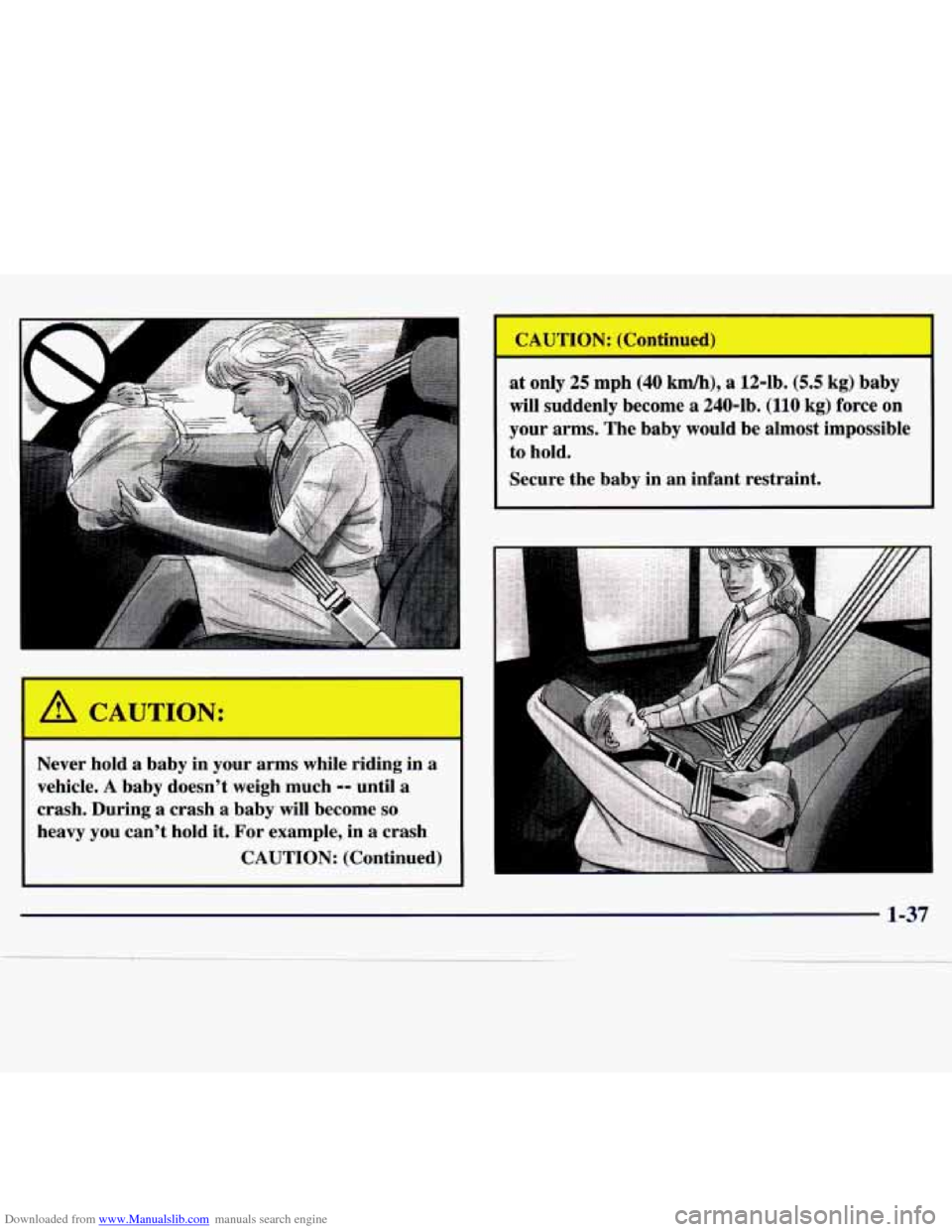
Downloaded from www.Manualslib.com manuals search engine I A CAUTION:
Never hold a baby in your arms while riding in a
vehicle.
A baby doesn't weigh much -- until a
crash. During a crash a baby will become so
heavy you can't hold it. For example, in a crash
CAUTION: (Continued) at
only 25 mph (40 km/h),
a 12-lb. (5.5 kg) baby
will suddenly become a 240-1b. (110 kg) force
on
your arms. The baby would be almost impossible
to hold.
Secure the baby in an infant restraint.
1-37
Page 46 of 386

Downloaded from www.Manualslib.com manuals search engine . .. .
A rear-facing infant restraint (B) positions an infant
to face the rear
of the vehicle. Rear-facing infant
restraints are designed for infants of up to about
20 lbs. (9 kg) and about one year of age. This type
of restraint faces the rear
so that the infant’s head,
neck and body can have the support they need in a
crash. Some infant seats come in
two parts -- the
base stays secured in the vehicle and the seat part
is removable.
1-39
Page 49 of 386
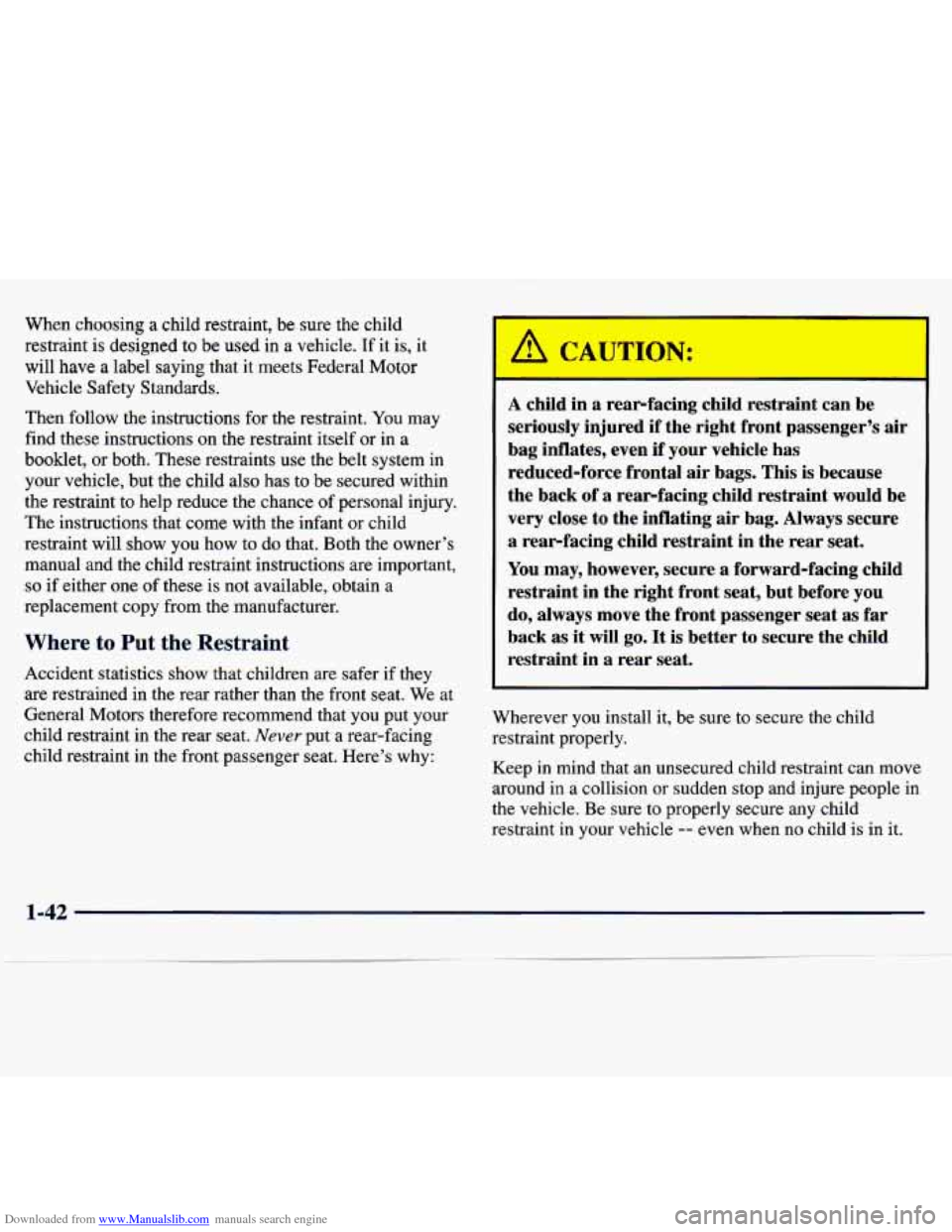
Downloaded from www.Manualslib.com manuals search engine When choosing a child restraint, be sure the child
restraint
is designed to be used in a vehicle. If it is, it
will
have a label saying that it meets Federal Motor
Vehicle Safety Standards.
Then follow the instructions for the restraint. You
may
find these instructions on the restraint itself or in a
booklet, or both. These restraints use the belt system in
your vehicle, but
the child also has to be secured within
the restraint to help reduce the chance of personal injury.
The instructions that
come with the infant or child
restraint will show you how
to do that. Both the owner’s
manual and the child restraint instructions are important,
so if either one of these is not available, obtain a
replacement copy from the manufacturer.
Where to Put the Restraint
Accident statistics show that children are safer if they
are restrained in the rear rather than the front seat. We at
General Motors therefore recommend that you put your
child restraint in the rear seat.
Never put a rear-facing
child restraint in the front passenger seat. Here’s why:
A child in a rearfacing child restraint can be
seriously injured
if the right front passenger’s air
bag inflates, even if your vehicle has
reduced-force frontal
air bags. This is because
the back
of a rearfacing child restraint would be
very close to the inflating air bag. Always secure
a rearfacing child restraint in the rear seat.
You may, however, secure
a forward-facing child
restraint in the right front seat, but before you
do, always move the front passenger seat as far
back as it will go.
It is better to secure the child
restraint in
a rear seat.
Wherever you install it, be sure to secure the child
restraint properly. Keep
in mind that an unsecured child restraint can move
around
in a collision or sudden stop and injure people in
the vehicle. Be sure to properly secure any child
restraint
in your vehicle -- even when no child is in it.
1-42